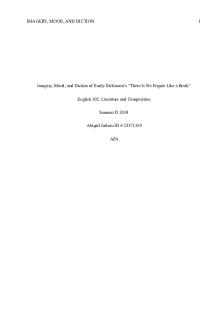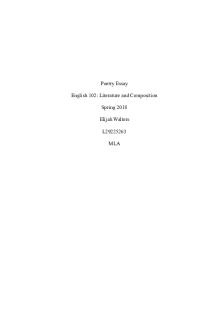William Butler Yeats Poetry analysis Essay nswcuriculum PDF

| Title | William Butler Yeats Poetry analysis Essay nswcuriculum |
|---|---|
| Course | Strategy And Leadership In Research |
| Institution | Monash University |
| Pages | 2 |
| File Size | 39 KB |
| File Type | |
| Total Downloads | 77 |
| Total Views | 146 |
Summary
Essay on William Butler Yeats Poetry....
Description
Yeats’ poetry extensively reveals the conflict caused by an individual’s attempt to resist change and maintain idealised stability in life. He does so through the reoccurring depiction of change as detrimental but inevitable in society, paralleled by his epoch of loneliness in senescence. The prominence of this idea is portrayed by his use of tone and contrast in his poems ‘Easter 1916’ through where he discusses his inner political controversies and ‘Wild Swans at Coole’ in the ways he compares the melancholy of aging to the transcendent beauty around him. Yeats’ elegy ‘Easter 1916’ explores the disastrous effects of forced change which disrupts the stability of life. However, his strong patriotic values interfere with his pacifistic outlook on violence, leading to his inner conflict. The critical tone in “was it needless death after all?” highlights the futility of the violence and deaths of the rebel nationalists. The line is emphasised by the use of the rhetorical question which provokes active reflection from the audience. Yeats goes on to accuse the rising “to trouble the living stream”. The personification of the living stream represents the common Irish life and indicates Yeats’ disapproval in response to the chaos, disruption and change caused by the uprisings. Furthermore, he associates negative connotations to the change caused by the havoc by stating ‘a terrible beauty is born’. The oxymoron of beauty being terrible, the modality of the words and its repetition throughout the poem creates an echoing focus on the damaging change brought by the Easter rising. The overall tone of disdain stresses his disapproval of the actions of the Irish rebels. However, although Yeats was critical of the violence, he shared their patriotic beliefs which are further explored in the following paragraph. The juxtaposition of his pacifistic values that resist change brought by violence and his strong patriotism is what heightens his inner conflict on this topic. ‘Easter 1916’ can be seen as a tribute to the rebels or an indictment of extremism; just as Yeats’ resistance to change is contrasted by his drive for Irish independence shaping hisconfliction. The poem expresses Yeats as constantly in contradiction with himself because he supports the nationalist values of the rebels however, he is appalled by the violence of the rising. Yeats directly references many of the leaders he was familiar with for example “this man” referencing Patrick Pearce, when he says, “so sensitive his nature seemed, so daring and sweet his thought.” The anaphora used in this line emphasises the reflective tone of the narrator who is critical of the nationalist and his actions. It generates an emotional response of animosity from the audience as they perceive the man as deceitful. However, it also seeks to engage the reader to feel sorry for the loss of a good man. This contradictory message reflects Yeats’ conflict on the topic. Yeats was personally acquainted with the leaders of the rising as he “met them at close of day” and often shared “polite meaningless words”. Therefore, the easter rising and the brutal response of the British officials to sentence the leaders to death had a significant impact on Yeats and increased his inner conflict. Yeats condemned the violent approach of the rebels however he strongly supported William Blake's concept that “without contraries, there is no progression” which is reflected in this poem. ‘Easter 1916’ conveys a critical approach to the Easter Rising and Yeats’ resistance to change however, it also displays his confliction as he tries to find meaning from the upheaval and chaos of the changing world. In “Wild Swans at Coole”, Yeats also focuses on his inner conflict caused by his inability to eternalise youth and vitality accentuated by the contrast between the transcendent beauty
of the swans in comparison to his own companionless life as he transitions from youth to old age. Yeats consistently uses natural imagery such as “autumn beauty” and “October twilight” to emphasise the passage of time and declining beauty. “The nineteenth autumn has come upon me” indicates the all-consuming nature of old age as time passes and changes occur. The salient feature in this poem is the swans. Yeats describes them as “mysterious, beautiful” and “brilliant creatures”. The ambivalent tone depicted in “and now my heart is sore” explains the weariness felt by the persona as a result of inevitable human aging. This is contrasted by the swans whose “hearts have not grown old”. The swans become a symbol of permanence and eternity juxtaposing the persona’s constantly changing life. Just as Yeats references that “all changed, changed utterly” in ‘Easter 1916’ he also states that “all’s changed” in. ‘Wild Swans at Coole’ signifying the consistent, interlinking theme of change as detrimental to an individual. Overall, the comparison between the melancholy of the change in his life as he grows old and the forever unchanging beauty of the swans indicates Yeats’ internal struggle to accept change and the envy he feels towards the eternal beauty of the swans. William Butler Yeats explores the conflict within individuals caused by times of change by addressing his personal experiences of internal struggle such as in his attempt to resist change or adjust to the changing world around him. Both ‘Easter 1916’ and ‘Wild Swans at Coole’ demonstrate this idea effectively through Yeats’ use of tone, emphasis and contrast. It causes us to realise the realities of change as inevitable....
Similar Free PDFs

Poetry Analysis Essay Examples
- 7 Pages

Poetry Essay - Grade: A+
- 5 Pages

Gwen Harwood Poetry Analysis
- 6 Pages

Poetry analysis god\'s grandeur
- 4 Pages

Essay Blazon poetry
- 2 Pages

Poetry Analysis 10 questions
- 1 Pages

Essay Poetry - Grade: A
- 3 Pages

Chimney Sweeper Poetry Essay
- 4 Pages

Poetry Essay - Grade: 80%
- 6 Pages

Poetry Essay - Grade: B
- 5 Pages

William Blake essay questions
- 4 Pages
Popular Institutions
- Tinajero National High School - Annex
- Politeknik Caltex Riau
- Yokohama City University
- SGT University
- University of Al-Qadisiyah
- Divine Word College of Vigan
- Techniek College Rotterdam
- Universidade de Santiago
- Universiti Teknologi MARA Cawangan Johor Kampus Pasir Gudang
- Poltekkes Kemenkes Yogyakarta
- Baguio City National High School
- Colegio san marcos
- preparatoria uno
- Centro de Bachillerato Tecnológico Industrial y de Servicios No. 107
- Dalian Maritime University
- Quang Trung Secondary School
- Colegio Tecnológico en Informática
- Corporación Regional de Educación Superior
- Grupo CEDVA
- Dar Al Uloom University
- Centro de Estudios Preuniversitarios de la Universidad Nacional de Ingeniería
- 上智大学
- Aakash International School, Nuna Majara
- San Felipe Neri Catholic School
- Kang Chiao International School - New Taipei City
- Misamis Occidental National High School
- Institución Educativa Escuela Normal Juan Ladrilleros
- Kolehiyo ng Pantukan
- Batanes State College
- Instituto Continental
- Sekolah Menengah Kejuruan Kesehatan Kaltara (Tarakan)
- Colegio de La Inmaculada Concepcion - Cebu




